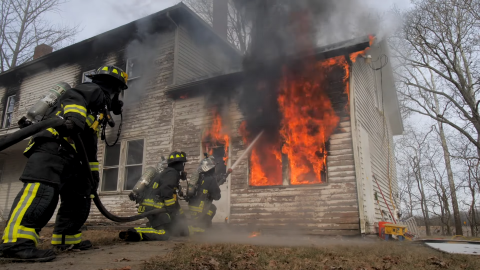After experts warned for years that the proliferation of furniture foam and plastic were making home fires more deadly, a multidecade trend in declining home fire deaths has reversed itself. The number of U.S. home fire deaths reached a 14-year high in 2021, according to the most recent National Fire Protection Association data.
Furniture foam, furniture plastics and other oil-based, synthetic furnishings and building products burn rapidly and quickly fill homes with toxic smoke, reducing the time to escape to less than four minutes from more than thirty minutes in the past, studies have shown.
Experts point first to the proliferation of synthetics in homes as an explanation for the increasing fire deaths, but also cite differences in how homes are designed. They have warned for years the trends would make fires more deadly and erode large gains made from smoke alarms and other safety measures.
"When you sit on the couch, you're essentially sitting on a block of gasoline. So, the fires have gotten hotter, they've gotten faster, and they've gotten more toxic," Maryland State Fire Marshal Brian S. Geraci said.

Home design also has played a role, experts said, with open-concept designs featuring fewer walls and doors giving synthetic-fueled fires the oxygen and freedom they need to move swiftly. Homes also have gotten larger, with multiple stories putting more space between occupants and exits than the ranch or split-level homes of the past.
"If you see how fast the fire develops, you also know that unless the fire department is almost right next door, they will not make it there in time," Birgitte Messerschmidt, research director of the fire protection association, said. "The fire department used to show up to a fire in a house, and now they show up to a house on fire."
Experts interviewed by Newsweek say residential fire sprinklers, which international standards have called for since 2009, are the only comprehensive countermeasure to the many contributors they see causing the increasing deaths. Nearly all states have rejected such mandates after pressure from builders concerned with their cost, which one sprinkler industry group pegged at about 1 percent of the cost of a new home.
The overall home fire toll in 2021, 2,840 deaths, was still 47 percent lower than the largest on record, 5,400 in 1981. However, the recent increase in deaths—from a low of 2,380 in 2012—has occurred even as the number of fires has declined to a low of 338,000 in 2021 from more than 700,000 in the 1980s.
As a result, fires in 2021 were more deadly than in all but nine of the prior 42 years of data compiled by the National Fire Protection Association, with more than 8 deaths per 1,000 fires.
More recent data from state fire marshals who have made public pleas in the news media of their states for more fire safety vigilance suggest the trend of increasing deaths may even be getting worse.
Ohio's 2022 death toll from all fires—most of which are home fires—was 156, double the 2020 total of 78 and the highest total since 2006, when 200 people died, according to the Ohio State Fire Marshal's Office.
Minnesota's toll from all fires rose for the fourth straight year in 2022 to 70 fire-related deaths, the largest tally since 86 were lost in 1995, according to the state fire marshal.
Geraci made a plea for better compliance with fire safety in a letter to news media earlier this year after nearly 40 people died in the first three months, the largest total since 2004.
"This deeply saddens and concerns me to my core," Geraci wrote. "We need to slow this trend down immediately."
The fire association's home fire death statistics include all single or multiple-family houses, condominiums, apartments and manufactured homes, but exclude hotels and motels, dormitories and rooming houses.
Overall, 3,800 people died in all fires in 2021, according to the association, three-quarters of them in home fires. That overall total includes 110 deaths from wildfires and other outdoor fires, a decline from the 140 deaths in 2019.
Vehicle fire deaths more than doubled from their 2009 low of 260 deaths to 650 in 2021, the highest total since 1992's 665 deaths. Experts note that car interiors are also now more commonly made out of synthetic products, including foam.
Like the increase in home fire deaths, the increase in vehicle fire deaths has occurred even as the number of vehicle fires has declined from a high of 459,000 in 1988, when a record 800 people died, to 164,000 in 2013, when 300 died. There were 174,000 vehicle fires in 2021.
Geraci said vehicle fire deaths in Maryland typically occur in accidents where a car's engine or fuel lines are compromised and occupants are trapped.
"Cars are burning faster now, too, with all the plastic," Geraci said.
State fire marshals and safety researchers Newsweek spoke with were not calling for an end to furniture foam. They said more public education about the importance of smoke alarms and other successful safety measures would help battle complacency and reduce the death toll, but pointed to home fire sprinklers as the only way to effectively address the many factors of modern home fires that have made escape less likely.
"There's so many wrongs that we have to right, the quickest way to right them and the easiest way to right them is with one solution, which is residential sprinklers," UL Fire Safety Research Institute Vice President and Executive Director Steve Kerber said. "The data there is very clear. The challenge there is cost, which has also been brought down significantly."
A 2020 report by the fire protection association found the chance of fatalities in residential fires was nine times higher in homes with no smoke alarms or sprinklers than in homes with hardwired smoke alarms and sprinklers. The hardwired alarms are more effective than ones powered by batteries that can die or be removed and forgotten about after a false alarm.
Nonetheless, only a third of buildings with 50 or more apartments or condos have sprinklers, according to the association. Only 14 percent of buildings with two or more apartments, condos or other homes have them and only two percent of single-family homes have them.
Fire sprinklers are primarily aimed at making it possible to escape a fire, but often also have the benefit of preventing damage to a home.
According to the fire association, an unexpected activation of a fire sprinkler is extremely rare as they only activate when high temperatures are reached in a room, such as more than 150 F. Unlike in the movies, where all sprinkler heads often activate at once, in 77 percent of fires only one sprinkler head in the vicinity of a fire activates, keeping any damage caused by sprinklers to a minimum, according to the fire association.
States, municipalities and other jurisdictions develop their building codes from standards set by the largest international association of building safety professionals, the International Code Council. ICC standards have called for sprinklers in all new one- and two-family homes since 2009, but only Maryland, California, Washington, D.C., and several smaller jurisdictions have adopted the requirement.
Forty-six states have passed legislation rejecting the ICC's sprinkler standard or adopted statewide building codes that do not include the standard, according to the National Association of Home Builders, which opposes the requirement. In 26 of the states, local jurisdictions are barred from adopting a code that includes the standard.
Officials from the builder's association say the fire protection association's data does not specify the age of homes where fire deaths are occurring and point to older homes as the driver of the trend in increasing deaths. They say adding smoke alarms to older homes is a far more cost-effective way to reduce fire deaths and that more costly sprinkler mandates don't benefit those who cannot afford a new home. Building codes already require smoke alarms in new homes.
"Adding a sprinkler requirement for new construction will not address the fires in these older, substandard homes," building association CEO Jim Tobin said in a statement sent in response to a Newsweek interview request.
Tobin said the smoke alarm mandate and many other modern building code requirements "are specifically intended to reduce the risk of fire and increase protection against fire."
According to the National Fire Sprinkler Association, fire sprinklers make up about one percent of the cost of a new home, can increase its value and can reduce insurance costs.
Some jurisdictions allow developers to increase profits by building homes closer together with fewer, smaller roads and fewer hydrants if they agree to install fire sprinklers throughout a development, according to the sprinkler association.
A 2013 fire association study found the national average cost to be $1.35 per sprinklered square foot—a 16 percent drop since 2008— or $6,026 per home. Adding them to an existing home can be much more costly, with some estimates for historic buildings reaching $10 per square foot.
While the most common cause of deadly home fires is smoking indoors, according to data from the association, other common causes such as space heaters, older appliances and faulty wiring are more likely to exist in older homes.
As a result, many fire officials nationally offer installation of free smoke alarms, and state fire marshals Newsweek spoke with continued to stress proven fire safety measures for all homes, including developing escape plans and closing bedroom doors at night.

Geraci, the Maryland fire marshal, said there hasn't been a single death in sprinklered homes since his state mandated them. After the state's surge in deaths in non-sprinklered homes earlier this year, he made a public plea for residents to be more vigilant.
"One thing that hasn't changed over all these years is the complacency," Geraci said. "It's not going to happen to me, it's going to happen to my neighbor, it's going to happen to the guy down the street. And I'm not thinking about having a fire in my home at two in the morning. And not making sure my smoke alarms are working."
Kerber said even when smoke alarms are installed and working as the builder's association stresses, deaths can still occur because of how little time occupants have to escape a modern home fire. He said two out of five fire deaths occur in homes with a smoke alarm.
"So that just speaks to how fast fire spreads also...even with smoke alarms in place, sometimes that early warning is not early enough with how fast fire spreads today," Kerber said, stressing the importance of sprinklers. "How many fire deaths is this country willing to tolerate?"
Matt Clark can be reached at m.clark@newsweek.com or find him on X at @MattTheJourno.
Fire Safety Vigilance
State fire marshals told Newsweek they often hear from fire victims how they thought it could never happen to them. They offered these tips to avoid complacency and protect yourself and loved ones from fire dangers.
"A lot of what we see is very preventable," said Interim Minnesota State Fire Marshal Amanda Swenson. "It's just things that maybe people have done 100 times before without incident, but then that one time disaster strikes and unfortunately they perish in a fire."
- Install and regularly test smoke alarms in every floor of your house
- Develop a fire escape plan with all occupants of your home
- Close your bedroom door at night to prevent fire from spreading and give firefighters time to respond if you are trapped
- Avoid smoking indoors
- Stay in the kitchen when cooking
- Don't overload electrical outlets
- Keep space heaters three feet from anything that can burn
- Call 911 right away in the event of a fire
- Never enter a burning building










